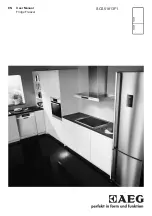
DO'S AND DON'TS
Do- Check contents of the freezer at regular intervals.
Do- Clean your freezer regularly.
Do- Keep food for as short a time as possible and adhere to "Best Before",
"Use By" dates.
Do- Store commercially frozen food in accordance with the instructions given
on the packets that you buy.
Do- Always choose high quality fresh food and be sure it is thoroughly clean
before you freeze it.
Do- Prepare fresh food for freezing in small portions to ensure rapid freezing.
Do- Wrap all foods in aluminium foil or freezer quality polythene bags and
make sure any air is excluded.
Do- Wrap frozen food when you buy it and put it in to the freezer as soon as
possible.
Do- Separate food in the compartments. This will enable you to find food quickly and
avoid excessive door opening therefore save electricity.
Do- Remove ice cream from the freezer 10-20 minutes before serving.
Don't- Leave the door open for long periods as this will make the freezer more
costly to run.
Don't- Put hot food into the freezer. Let it cool down first.
Don't- Put liquid-filled bottles or sealed cans containing carbonated liquids into
the freezer as they may burst.
Don't- Store poisonous or dangerous substances in the Freezer. Your freezer has
been designed for the storage of edible foodstuffs only.
Don't- Exceed the maximum freezing capacity (10 kg in any 24 hours) when
freezing fresh food.
Don't- Consume ice-cream and water ices direct from the freezer. The low
temperature may cause 'freezer burns' on lips.
Don't- Freeze fizzy drinks.
Don't- Try to keep frozen food which has thawed, it should be eaten within 24
hours or cooked and refrozen.
Don't- Remove items from the freezer with wet hands.
Don't- Close the door before placing the fast-freeze compartment cover in its
place.
Don’t- Leave frozen food at room temperature to thaw; the best way to defrost
food is to put it in the fridge to thaw slowly. Make sure you avoid defrosting
food or food juices drip onto other food.
Don’t Remove the plastic cover on the rear wall.
Don’t Damage the pipes on the appliance.
PROBLEM SOLVING / TROUBLE SHOOTING
If the appliance does not operate when switched on, check:
• The plug is inserted properly in the socket and that the power supply is on. (To
check the power supply to the socket, plug in another appliance)
• The fuse has blown/circuit breaker has tripped/main distribution switch has
been turned off.
• The temperature control has been set correctly.
• New plug is wired correctly if you have changed the fitted moulded plug.
If the appliance is still not operating after the above checks, please refer to the section on
“How To Obtain Service”.
Please ensure that above checks have been made as a charge will be made if no
fault is found.
11


































